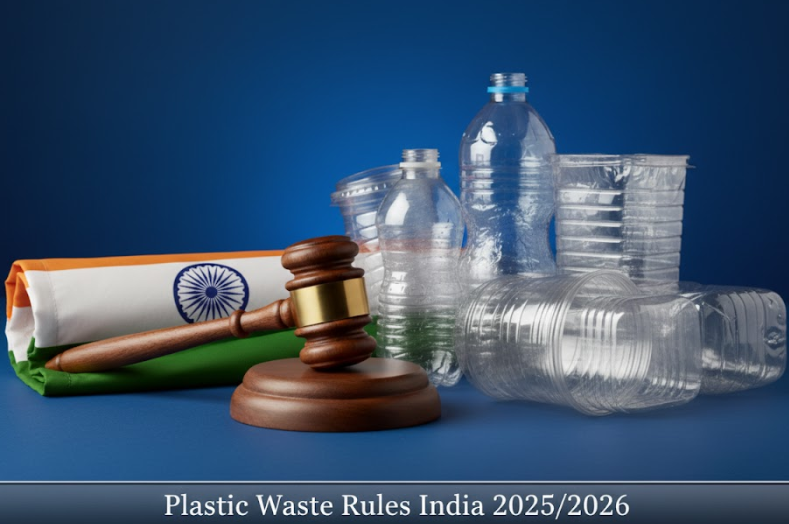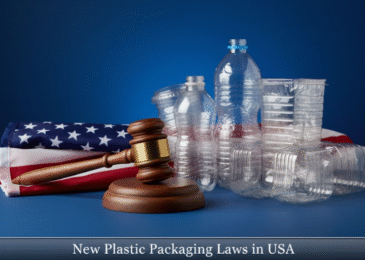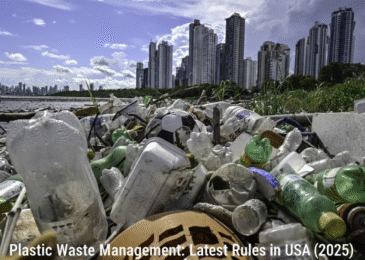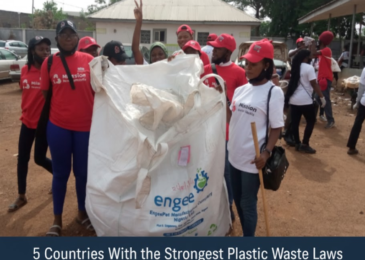If you buy anything in plastic today, there’s a good chance you’ll spot a new detail—a small QR code or barcode right on the wrapper.
Since July 2025, this simple mark a requirement under India’s new plastic waste management rules, and it tells the entire story of that piece of plastic:
- Where it came from
- What it’s made of
- And, crucially, who is responsible for it at every stage
This is a huge shift in how we handle plastic waste in India.
Until now, most plastic just disappeared into landfills or worse, into the environment.
India generates around 9 million tonnes of mismanaged plastic waste each year.
So tackling this mess is not just a policy goal; it’s a necessity.
These new rules move us from vague promises to real, trackable accountability. Now, every company and every citizen is part of the solution.
So, what exactly is changing? How do the 2025 plastic waste management rules in India affect businesses, investors, and everyday people? And, most importantly, how will this impact the fight against plastic pollution?
Let’s break it down, step by step, so you know exactly what these changes mean—and how we can all move forward.
What are India’s latest plastic waste management rules for 2025?
The plastic waste management rules of 2025 signal a new era of accountability.
Unlike in the past, plastic packaging can no longer vanish into ambiguity.
We’ll see how barcode/QR code introduction and reinforcing the pre-existing 2022 rules are making this possible.
Introducing Barcode/QR Code Marking On Plastic Packaging
As of 1 July 2025, every plastic package must carry a barcode or QR code under the amended Rule 11A.
Think of it as an Aadhar card but for plastics. It makes traceability mandatory. Every plastic pack, pouch, or bag is linked to a digital record of origin, movement, and final disposition.
It means:
- You can trace each item across its entire life cycle
- No one can “lose” plastic waste in the system anymore
- Supply chains go from zero transparency to full visibility
But it doesn’t stop at tracking. Rule 19 (we’ll come to it later) steps things up further, introducing clear penalties if you break the rules.
Next we will look into another important improvisation, which involves updating the 2022 plastic waste management rules in India.
How Did the 2022 Rules Set the Stage?
July 2022 marked the implementation of an ambitious single-use plastic ban in India.
In 2025, some additions have been introduced to these foundational rules:
Ban on 19 single‑use plastic items
In 2022, India prohibited the manufacture, sale, import, and use of 19 single‑use plastic items (like cutlery, plates, and wrappers).
2025 update: The ban continues, and enforcement is now supported by mandatory traceability (barcode/QR).
120 microns rule for carry bags
Since December 2022, plastic carry bags thinner than 120 microns have been disallowed.
2025 update: The QR/barcode disclosures on packaging must include the thickness information.
Strengthened EPR and mandatory reporting
The 2022 framework required Producers/Importers/Brand Owners (PIBOs) to register, report, and manage collection and recycling obligations. They also are expected to submit annual returns.
2025 update: The 2025 rules insert a new Rule 11A, which mandates marked barcode/QR code/unique identification on plastic packaging from 1 July 2025. It also expands on penalty enforcement under new Rule 19 for violations.
So what does this mean for businesses and industries?
Industries must revamp packaging, tracking, and disposal strategies.
Investors must re-evaluate risk in businesses dependent on old plastic systems.
Next we will look into EPR for plastic packaging in India. This defines how obligations flow across the value chain.
What is EPR (Extended Producer Responsibility) for plastic packaging?
EPR And Producers’ Responsibility For The Entire Life Cycle
Think of EPR like this: If you throw a party, you clean up later.
Extended Producer Responsibility works on the same principle. Companies that put plastic packaging into the market must take responsibility for collecting and recycling an equivalent amount.
This is what the regulations under the EPR plastic packaging in India imply.
Who Needs To Register?
Producers, Importers, and Brand Owners (PIBOs) handling plastic packaging must register on the CPCB EPR portal.
Categories Of Plastics I–IV
- Rigid packaging (bottles, containers)
- Flexible packaging (pouches, films)
- Multi-layered plastics (laminates, snack packs)
- Compostable plastics
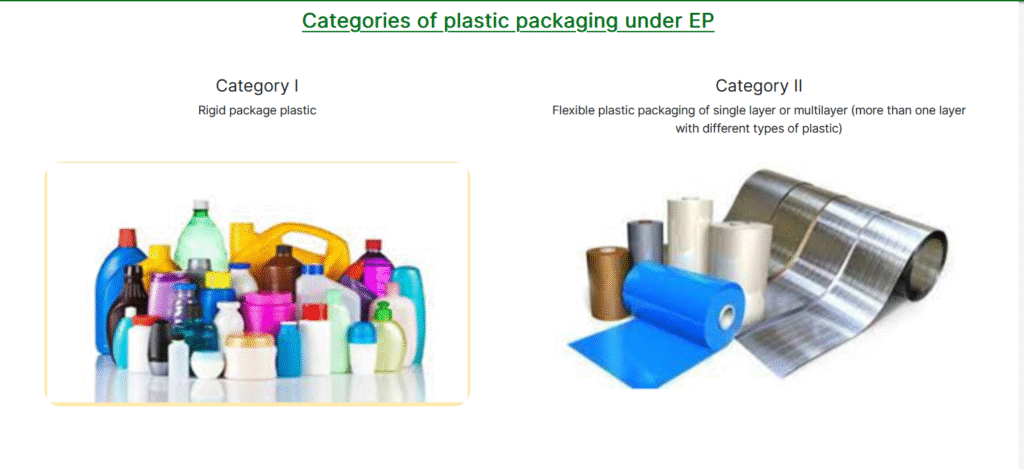
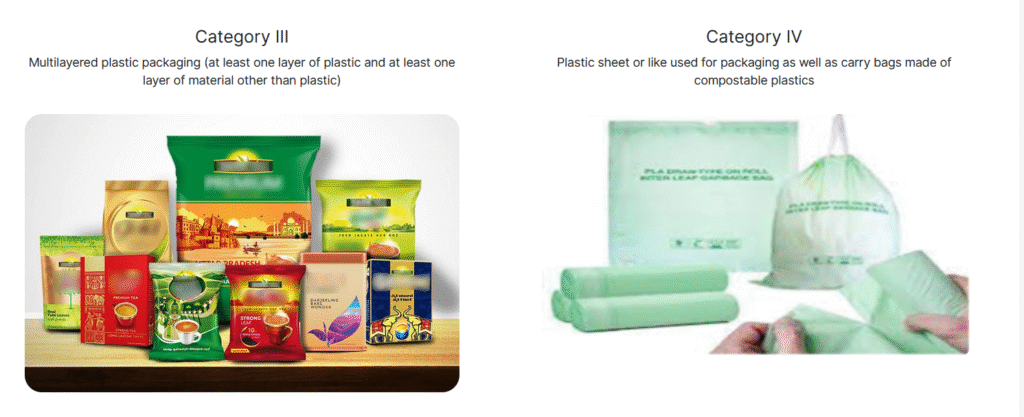
How To Register On The CPCB EPR Portal?
The main steps in the registration process involve registration on the portal, declaration of product categories, submitting an ER action plan, and getting a compliance certificate.
We will look into the full registration process in detail in a later section.
Timeline And Compliance
- From 2025 onward, PIBOs must meet their category-wise recycling targets aligned with how much plastic they put into the market.
- By 2029, India aims for 60% recycling of all plastic packaging.
What EPR Means For A Business
EPR isn’t just another part of the plastic waste management rules in India.
For businesses, EPR is reinventing the way they operate.
Here’s how:
- Businesses can no longer pass on the cost of plastic waste to society.
- From production to final disposal, companies are now responsible for the entire life cycle of their packaging.
- EPR pushes brands to rethink their packaging, whether that means using less plastic, switching to new materials, or investing in better recycling systems.
- Importers aren’t left out either. If you import plastic raw materials or finished goods, EPR covers you too.
All players, big or small, are pivoted to accountability. Under EPR, waste is transformed from a disposal problem into a business asset.
In the next section, we’ll see precisely how barcode/QR traceability enables this enforcement in practice.
How does the new QR code tracking system work?
The QR code system transforms every plastic package into a tracked digital entity.
Let’s see how it works in closing the compliance loop.
Who must comply?
As of 1 July 2025, Producers, Importers, or Brand Owners (PIBOs) must include:
- a barcode or QR code,
- or use a product information brochure,
- or display a unique number
for all plastic packaging.
What information must be provided?
The code must embed or link to information such as:
- Manufacturer identity
- Material type
- Packaging weight or volume
- EPR registration / compliance info
- Waste collection instructions
The entity must notify the CPCB about which method (barcode, QR, or brochure) is used. CPCB will publish and update a public registry quarterly with compliant producers/importers.
This gives regulators and consumers visibility. Anyone can scan or cross-check to see whether the product is following the plastic waste management rules in India.
As traceability is embedded in the packaging itself, the packing and compliance functions are no longer separate. It closes the loop: the product carries its compliance credentials.
But compliance needs smooth operation. Let’s see next how registration and filing work on the CPCB portal.
How to register and file returns on the CPCB EPR Portal?
We had briefly touched upon the registration process earlier in this article.
Let’s look into its details and what it entails for you as a PIBO.
The process for filing works with the following steps:
- Visit the Portal
Go to the Centralized EPR Portal maintained by CPCB for plastic packaging registration. - Register as a PIBO
Provide your entity type (Producer, Importer, Brand Owner), address, category of packaging (rigid, flexible, multilayer, compostable), and annual volumes. - Declare Your Action Plan
Submit your plan to collect, recycle, or dispose of the plastic waste you generate. - Annual Return Submission
Each financial year, file your actual figures. This will include collection done, recycling achieved, shortfalls, etc. - Download Compliance Certificate
Once approved, you’ll get a compliance certificate. Your name and registration will also appear on CPCB’s published list of compliant entities.
Next we will look into what happens when compliance fails. This brings us to the penalties under the plastic waste management rules in 2025.
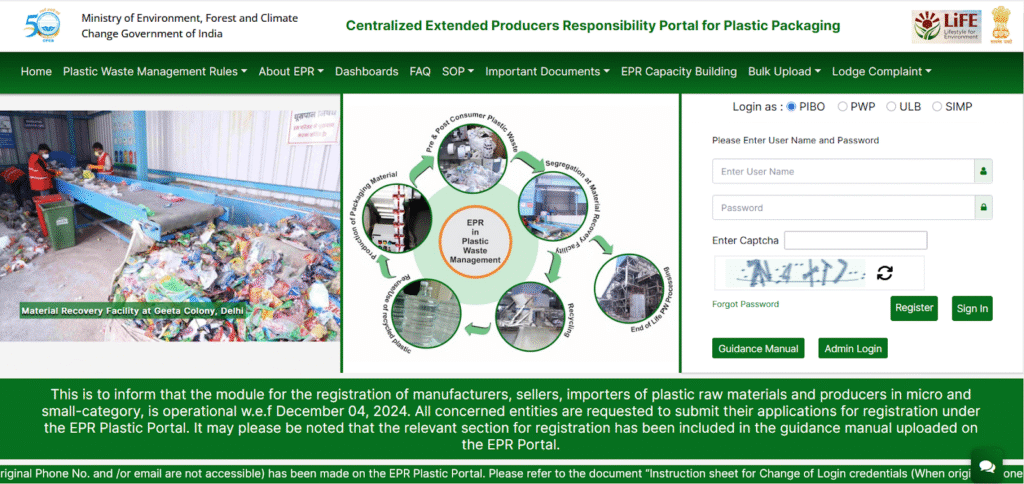
The CPCB EPR portal for registration
What Are the Penalties for Non-Compliance?
Rules are no longer vague warnings with the penalties under the new plastic waste management rules in India. The introduction of Rule 19 makes them real and quantifiable.
What Is Rule 19?
Rule 19 is a newly inserted penalty clause in the PWM rules.
Under it, any person who violates or fails to comply with these rules is liable to be penalized. This is covered under Section 15 of the Environment (Protection) Act, 1986, as per the 2025 amendment.
Penalties under Section 15 can range widely. It depends on the severity and duration of non-compliance.
Fines can range from ₹10,000 up to ₹15,00,000, plus additional daily fines for ongoing violations.
In practice, the CPCB has already issued show-cause notices to multiple PIBOs. This includes those who failed to submit their EPR returns or meet targets.
Penalties don’t stop at monetary fines. Enforcement actions can be taken against non-compliant PIBOs. This includes withdrawal of registration, blacklisting, or invalidation of permits.
These stronger penalties mean that non-compliance is no longer an environmental guilt. It’s a commercial risk. It forces every stakeholder to build compliance into their core operations.
What Is the Future of Plastic Waste Management in India?
India’s 2025 plastic waste rules signal a shift from symbolic regulation to enforceable accountability.
However, let’s be honest.
Traceability and collection alone won’t solve the challenge of 9 million tonnes of mismanaged waste annually.
The real solution lies in material innovation.
India produces about 500 million tonnes of agricultural residue each year.
This is a potential for next-gen packaging.
At Ukhi, we’re transforming this opportunity into reality.
Our EcoGran™ biopolymer, made from hemp, nettle, and flax, is a compostable, food-grade certified alternative. They are designed to work in tandem with existing manufacturing lines.
When packaging is compostable by design, the waste equation changes entirely. This makes it easier to meet EPR targets and lower environmental impact.
The plastic waste management rules in 2025 set the rules of engagement. It’s up to businesses to rise to the occasion.
It’s a win-win outcome for businesses that invest in circular materials, build collection infrastructure, and choose innovation over inertia.
Are you going to be one of them?
FAQs
What Are The New Plastic Waste Rules In India 2025?
They require barcode/QR code traceability and have updated EPR obligations. There are stricter penalties under Rule 19.
Who Must Register Under India’s 2025 Plastic Rules?
All Producers, Importers, and Brand Owners (PIBOs) involved in plastic packaging must register on the CPCB EPR portal.
What Is Rule 11A In PWM 2025?
Rule 11A mandates that plastic packaging carry a barcode, QR code, or unique number with traceable data.
What Are The Penalties Under Rule 19 In 2025?
Rule 19 allows penalties according to Section 15 of the Environment (Protection) Act for non‑compliance. Penalties can be monetary fines or punitive actions like blacklisting the entity.
Is Recycled Content Required By 2025 Rules?
Yes. New amendments propose minimum recycled content mandates for plastic packaging, phased across categories. E.g., for rigid packaging, the recycled content starts at 30% in 2025‑26, rising in subsequent years.


